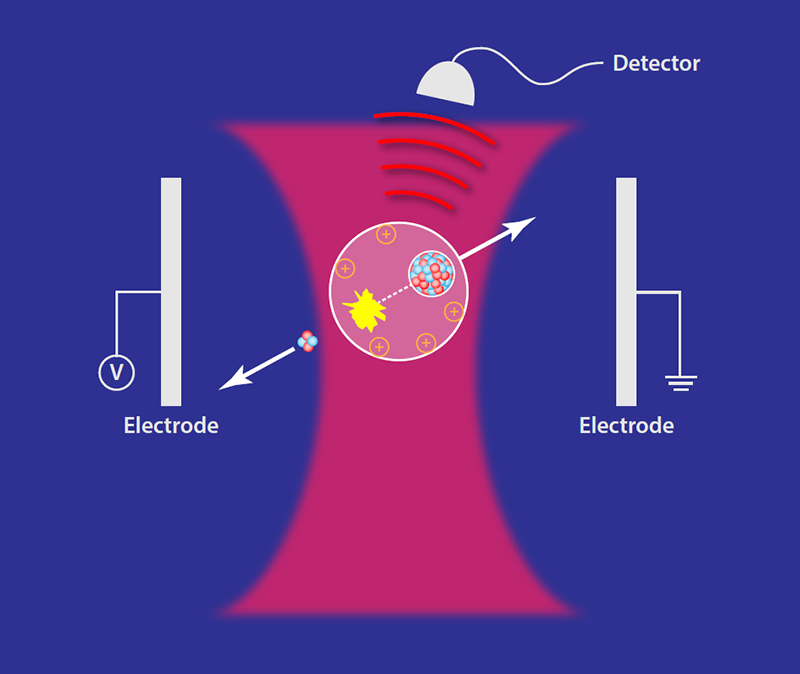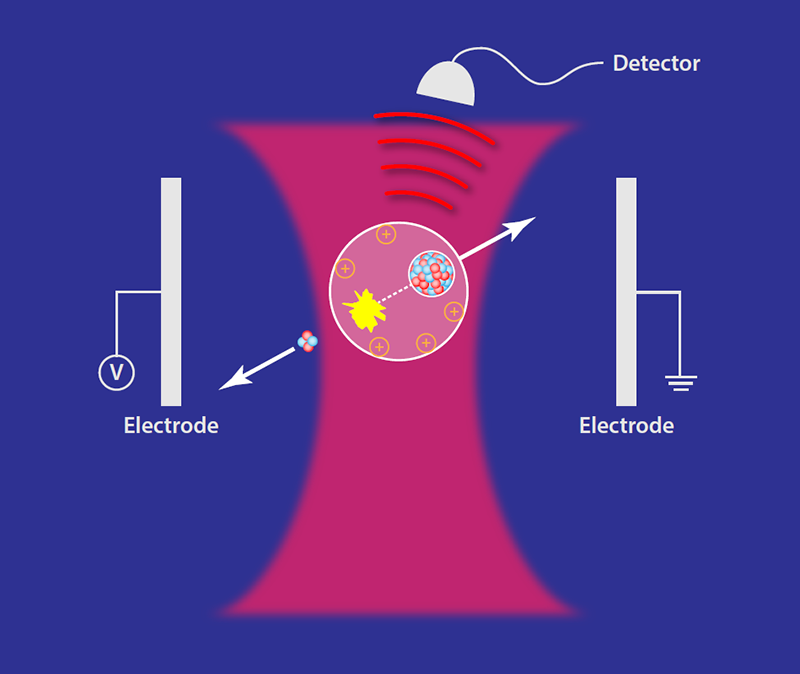Nuclear Decay Detected in the Recoil of a Levitating Bead
For centuries, physicists have exploited momentum conservation as a powerful means to analyze dynamical processes, from billiard-ball collisions to galaxy formation to subatomic particle creation in accelerators. David Moore and his research team at Yale University have now put this approach to work in a new setting: they used momentum conservation to determine when a radioactive atom emitted a single helium nucleus, known as an alpha particle (Fig. 1) [1]. The demonstration suggests that—with further improvements—researchers might be able to use this technique to detect other nuclear-decay products, such as neutrinos and hypothetical dark-matter particles (see also Special Feature: Sensing a Nuclear Kick on a Speck of Dust).
The basic idea is simple: if the radioactive atom is embedded in a larger object, then an outgoing decay product will exert a backreaction on that object, causing it to recoil in the opposite direction. But is it really possible to detect the recoil kick from a particle as small as a helium nucleus? The answer lies in how precisely we can measure the larger object’s momentum. One of the main limitations is friction: if the larger object is slowed down by frictional forces, then its motion won’t reflect the impulse from the decaying particle.
Moore and his team used a silica microsphere as their larger object, which they levitated under high vacuum to minimize friction. Levitation of microscopic objects using optical, electric, or magnetic forces provides extreme isolation from the environment [2]. Moreover, the light scattered by a levitated object can be used to track its position with high precision, which in turn enables precise control of the object’s motion via electrical or optical feedback. Levitated nanospheres in optical traps have been slowed via feedback to their quantum-mechanical ground state of motion [3, 4] and can measure forces as small as 10−20 newtons and accelerations as small as 10−7g with an observation time of 1 second [5].
In the Yale experiment, the first step was to implant silica microspheres with radioactive lead-212 atoms—a few dozen atoms within 60 nm of the surface of each microsphere. Following implantation, one microsphere at a time was levitated using a focused laser beam, which formed a so-called optical tweezer, a method first developed by Arthur Ashkin and colleagues [6] (see Focus: Nobel Prize—Lasers as Tools). Thanks to the circular polarization of the laser, the microsphere rotated at frequencies above 100 kHz, providing gyroscopic stability that fixed the orientation of the particle’s rotational axis. Next, the chamber enclosing the microsphere was pumped down to a pressure of around 10−10 atmospheres. Finally, recoil data were continuously recorded for each microsphere over two to three days. Lead-212 has a half-life of 10.6 hours, and the team was looking for evidence of its nuclear decay to the stable isotope lead-208 through the emission of alpha particles and beta particles (electrons). Data were acquired for six microspheres.
Two parallel methods allowed the researchers to pinpoint nuclear decays. The first method was electrical: the microsphere’s response to an oscillating electric field revealed how much excess charge it carried, which could be determined at the level of a single electron or proton. Any change in this value signaled that a nuclear decay had caused the ejection of charged particles. (A microsphere without implanted lead-212 showed no change in the excess charge over three days.) The second method was optical: light scattered by the microsphere provided precise information about the microsphere’s motion in the trap. The researchers used the first method to identify 83 events in which charge was carried away, then used the second method to reconstruct the impulse received by the microsphere for each event. Their key result is a histogram of the reconstructed impulse amplitudes, which were found to be consistent with the predicted response from alpha and beta decays. It is the alpha decays that contribute to the recoil signal; the beta decays contribute to the background but do not carry away sufficient momentum for the recoil to be resolved.
This result shows that a nuclear decay can be detected from the recoil kick on a silica microsphere that is 1012 times more massive than the decay products. Furthermore, by measuring both recoil and charge in parallel, the researchers boosted the sensitivity of their measurement so that it can detect events that occur as infrequently as once per day. One route to improve the sensitivity further is to use a smaller levitated object; Moore and colleagues have proposed studying neutrino properties with a sphere mass 100 times smaller than the one used in this study (see Synopsis: Synopsis: Searching for Ghost Particles with a Mechanical Sensor). A second route is to bring the sensitivity of microsphere momentum detection into the quantum regime, building on recent advances with sensors based on levitated nanospheres [3, 4].
The researchers point out that recoil-based detection addresses a shortcoming of conventional nuclear-decay detectors, which rely on the decay products to interact with the detection medium. Thus, it could be an enabling technology for decays involving noninteracting particles, such as sterile neutrinos or dark matter [5, 7]. Sterile neutrinos are hypothetical particles that are extremely lightweight and only interact with other particles through gravity, so if they exist, they will be hard to find. Dark matter is estimated to make up about 27% of the Universe, but its nature remains a mystery, with many ideas about what it might be (including sterile neutrinos). The techniques of Moore and colleagues could spot these elusive particles by identifying unaccounted-for momentum in radioactive-decay-induced recoils. However, being sensitive to recoils is not always a good thing: future trapped-ion-based quantum computers may be adversely affected by radioactive decays from nearby electrode surfaces. (Interestingly, quantum computers based on superconducting circuits face an analogous challenge owing to impinging cosmic rays.) With these experiments, Moore and colleagues remind us that momentum conservation is an inescapable fact of life.
References
- J. Wang et al., “Mechanical detection of nuclear decays,” Phys. Rev. Lett. 133, 023602 (2024).
- C. Gonzalez-Ballestero et al., “Levitodynamics: Levitation and control of microscopic objects in vacuum,” Science 374, eabg3027 (2021).
- L. Magrini et al., “Real-time optimal quantum control of mechanical motion at room temperature,” Nature 595, 373 (2021).
- F. Tebbenjohanns et al., “Quantum control of a nanoparticle optically levitated in cryogenic free space,” Nature 595, 378 (2021).
- D. C. Moore and A. A. Geraci, “Searching for new physics using optically levitated sensors,” Quantum Sci. Technol. 6, 014008 (2021).
- A. Ashkin et al., “Observation of a single-beam gradient force optical trap for dielectric particles,” Opt. Lett. 11, 288 (1986).
- D. Carney et al., “Searches for massive neutrinos with mechanical quantum sensors,” PRX Quantum 4, 010315 (2023).





